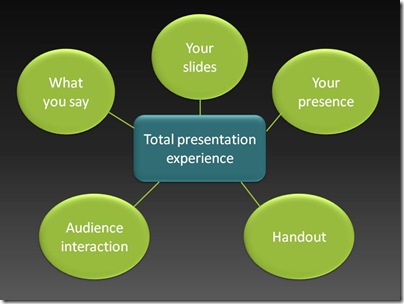Resumen ejecutivo
Some presenters treat handouts like an afterthought or even forget them altogether, justifying their action with: "They will just get trashed anyway." That kind of thinking becomes a self-fulfilling prophecy. When handouts are not designed well, they may get trashed. By contrast, quality handouts are used and ensure that your presentation is remembered favourably (WALLACE 1999). Here, you will find information and useful tips on how to prepare your handout properly, so that it supports your presentation with useful details and will not be trashed but used after the lecture.
Why to Prepare Handouts

Handouts are an important part of a good presentation. Source: MITCHELL (n.y.)
Your presentation handout is the lasting concrete manifestation of your presentation. As you can see on the picture, the handout is an important part of the total experience for the audience (MITCHELL n.y.). There are many benefits of preparing handouts when giving presentations/ lectures (see also presentation tricks), on the presenter’s and the audience’s side. The most important are listed below (adapted from WALLACE 1999).
Handouts Enable Presenters to:
- Create a positive impression before the presentation begins
- Ensure that the audience takes away the key ideas as intended
- Engage people at a deeper level, as they interact with the handout
- Keep the audience's attention focused on the subject
- Satisfy the needs of visual learners with graphics, tabs, diagrams, etc.
- Introduce experiential material for kinesthetic learners
- Present information at both novice and expert levels
- Simplify and navigate complex information
- Establish credibility
- Present more information than can be covered in the presentation
- Summarise and review.
Handouts Enable the Audience to:
- Concentrate on the ideas without having to take notes
- Capture any non-verbal data accurately
- Personalise the presentation with notes of their own ideas
- Hear, see and apply the presentation
- Increase their speed of comprehension
- Are given further reading material, references and weblinks for further research
- Retain new ideas longer
- Apply the information to specific tasks
- Find the information when they need it at a later date.
When to Prepare and Disperse Handouts
(Adapted from UNIVERSITY OF TEXAS LIBRARIES n.y.)
Handouts should be created at the same time that you are planning a session. This ensures that the information you include will be tailored to that specific course. It's a good idea to make copies of your handouts ahead of time to avoid problems such as copier jams five minutes before your session begins. Preparing handouts in a rush before a lecture is usually not working out well – if a handout is not appealing, it will not help you reach your targets and might be a waste of paper. Make sure your time management works out.
Opinions differ on when to pass out your handouts - some think it's best to give them out at the beginning or end of the session and others prefer the point at which the information is most relevant. Just remember that your students will probably look at them right when they receive them and will miss whatever you say in the next several minutes. Sometimes it can also be good to hand them out a week or some days before the lecture takes place, so that the participants can prepare the course with the given structure or reading material.
What Information to Include?
(Adapted from UNIVERSITY OF TEXAS LIBRARIES n.y.)
- An outline of the key ideas in your presentation.
- Specific information from your session to which your students will want to refer in the future.
- Further information or a bibliography for further research.
- Illustrations, charts, graphics, etc.
- Materials that learners may find difficult to obtain elsewhere
- Make part of your handout an activity guide that provides directions, steps or a worksheet.
- Remember, say no more than what is necessary - the urge to say too much can ruin a good handout.
Design Tips
(Adapted from UNIVERSITY OF TEXAS LIBRARIES n.y.; LONDON DEANERY 2011)
- Set off distinct parts of the handout using italics, shading, bolding or underlining.
- Bullet lists to make them easier to scan and understand.
- Leave a wide enough margin on every side for notes.
- Serif fonts (such as Times New Roman) are more distinctive in print than sans serif fonts (such as Arial).
- Use no more than three fonts in a single handout.
- Make sure to leave plenty of white space to avoid confusion.
- If you do have multiple handouts, make them distinguishable from each, e.g. by numbering, by using different colours, etc.
Checklist
(Adapted from UNIVERSITY OF TEXAS LIBRARIES n.y.)
When your handout is prepared, ask yourself the following questions:
- Does the information flow?
- Is the handout visually appealing?
- If a student were to forget everything you presented, would the information included in the handout help him/her recall the main ideas?
- Is your contact information included?
- Are helpful Websites or tips for finding additional information needed/included?
Handouts are usually a good tool to make sure the contents of an oral presentation can be reviewed by the audience after the presentation. It helps the audience focusing on listening rather than taking notes. For a good presentation, a handout should be prepared including further reading material and weblinks.
13 Best Practice Tips for Effective Presentation Handouts
Handouts - University of Texas
Guide on the Side - Why and How to Avoid Trashy Handouts
http://speakingaboutpresenting.com/
This website contains practical tips for effective handouts’ presentation.
http://www.faculty.londondeanery.ac.uk/
This website leads step-by-step through different parts of becoming a better lecturer. For example it gives information about how to prepare a handout.
